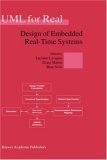

Most ebook files are in PDF format, so you can easily read them using various software such as Foxit Reader or directly on the Google Chrome browser.
Some ebook files are released by publishers in other formats such as .awz, .mobi, .epub, .fb2, etc. You may need to install specific software to read these formats on mobile/PC, such as Calibre.
Please read the tutorial at this link: https://ebookbell.com/faq
We offer FREE conversion to the popular formats you request; however, this may take some time. Therefore, right after payment, please email us, and we will try to provide the service as quickly as possible.
For some exceptional file formats or broken links (if any), please refrain from opening any disputes. Instead, email us first, and we will try to assist within a maximum of 6 hours.
EbookBell Team

4.8
54 reviews
ISBN 10: 144195368X
ISBN 13: 9781441953681
Author: Luciano Lavagno, Grant Martin, Bran V Selic
The complexity of most real-time and embedded systems often exceeds that of other types of systems since, in addition to the usual spectrum of problems inherent in software, they need to deal with the complexities of the physical world. That world—as the proverbial Mr. Murphy tells us—is an unpredictable and often unfriendly place. Consequently, there is a very strong motivation to investigate and apply advanced design methods and technologies that could simplify and improve the reliability of real-time software design and implementation. As a result, from the first versions of UML issued in the mid 1990’s, designers of embedded and real-time systems have taken to UML with vigour and enthusiasm. However, the dream of a complete, model-driven design flow from specification through automated, optimised code generation, has been difficult to realise without some key improvements in UML semantics and syntax, specifically targeted to the real-time systems problem. With the enhancements in UML that have been proposed and are near standardisation with UML 2. 0, many of these improvements have been made. In the Spring of 2003, adoption of a formalised UML 2. 0 specification by the members of the Object Management Group (OMG) seems very close. It is therefore very appropriate to review the status of UML as a set of notations for embedded real-time systems - both the state of the art and best practices achieved up to this time with UML of previous generations - and where the changes embodied in the 2.
Models, Software Models and UML – Bran Selic
UML for Real-Time – Sébastien Gérard, Francois Terrier
Structural Modeling with UML 2.0 – Øystein Haugen, Birger Møller-Pedersen, Thomas Weigert
Message Sequence Charts – David Harel, P. S. Thiagarajan
UML and Platform-based Design – Rong Chen, Marco Sgroi, Luciano Lavagno, Grant Martin, Alberto Sangiovanni-Vincentelli, Jan Rabaey
UML for Hardware and Software Object Modeling – Martyn Edwards, Peter Green
Fine Grained Patterns for Real-Time Systems – Bruce Powel Douglass
Architectural Patterns for Real-Time Systems – Bran Selic
Modeling Quality of Service with UML – Bran Selic
Modeling Metric Time – L. Motus
Performance Analysis with UML – D. C. Petriu, C. M. Woodside
Schedulability Analysis with UML – Marco Di Natale, Manas Saksena
Automotive UML – M. von der Beeck, P. Braun, M. Rappl, C. Schröder
Specifying Telecommunications Systems with UML – Thomas Weigert, Rick Reed
Leveraging UML to Deliver Correct Telecom Applications – Sergey Baranov, Clive Jervis, Vsevolod Kotlyarov, Alexander Letichevsky, Thomas Weigert
Software Performance Engineering – Connie U. Smith, Lloyd G. Williams
ym real deal
uml diagram for react components
uml xmi
xml uml
w-real estate
Tags: Luciano Lavagno, Grant Martin, Bran V Selic, UML, Design